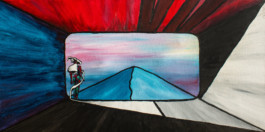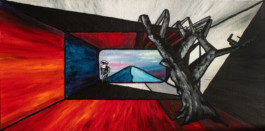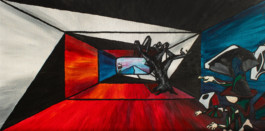



the unknown world: ? (Infernal figures)
Brief summary of "Infernal figures", by Ryunosuke Akutagawa:
The daughter of Yoshihidé, a great painter of renown with a very haughty character, beautiful and young, was welcomed into the home of the lord of Horikawa, a man of great kindness who commanded particular respect from the inhabitants of that region. Her father wanted her to return home, but the lord refused; instead, he commissioned her to paint The Screen of Infernal Figures. He asked her to depict Hell and its vices. In creating this screen, Yoshihidé often asked his apprentices to pose for him so that he could reproduce them in his painting, as the painter needed to see things before painting them. However, the models and apprentices he used were mistreated and even died, so cruel was what he did to them. Above all, he did not hesitate to sacrifice his daughter for his art. Finally, after the screen was handed over, the painter committed suicide, and the exercise was interpreted as a punishment from the Lord. Hell is him, Yoshihidé, with his pride and obsessive carelessness. For me, it represents humanity's crime of existing.
My artistic work takes up this story, which came into my life at the same time as we met, with Giuseppe, the manager of the new Japanese grocery shop Mogu in Neuchâtel, who subsequently delighted me with the idea of exhibiting a work in his windows. I wanted to reinterpret the main elements of the Paravent des figures infernales through the codes of the Unknown World. We can then decide to explore the elements used in greater depth, to finally realise that human beings in themselves constitute a sin by their very existence, that they can ruin the lives of others as well as ruin their own lives in full awareness of their actions.
acrylic on 50x100 cm canvas
2024




the unknown world: ? (Infernal figures)
Brief summary of "Infernal figures", by Ryunosuke Akutagawa:
The daughter of Yoshihidé, a great painter of renown with a very haughty character, beautiful and young, was welcomed into the home of the lord of Horikawa, a man of great kindness who commanded particular respect from the inhabitants of that region. Her father wanted her to return home, but the lord refused; instead, he commissioned her to paint The Screen of Infernal Figures. He asked her to depict Hell and its vices. In creating this screen, Yoshihidé often asked his apprentices to pose for him so that he could reproduce them in his painting, as the painter needed to see things before painting them. However, the models and apprentices he used were mistreated and even died, so cruel was what he did to them. Above all, he did not hesitate to sacrifice his daughter for his art. Finally, after the screen was handed over, the painter committed suicide, and the exercise was interpreted as a punishment from the Lord. Hell is him, Yoshihidé, with his pride and obsessive carelessness. For me, it represents humanity's crime of existing.
My artistic work takes up this story, which came into my life at the same time as we met, with Giuseppe, the manager of the new Japanese grocery shop Mogu in Neuchâtel, who subsequently delighted me with the idea of exhibiting a work in his windows. I wanted to reinterpret the main elements of the Paravent des figures infernales through the codes of the Unknown World. We can then decide to explore the elements used in greater depth, to finally realise that human beings in themselves constitute a sin by their very existence, that they can ruin the lives of others as well as ruin their own lives in full awareness of their actions.
acrylic on 50x100 cm canvas
2024


